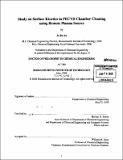Study of surface kinetics in PECVD chamber cleaning using remote plasma source
Author(s)
An, Ju Jin
DownloadFull printable version (25.36Mb)
Other Contributors
Massachusetts Institute of Technology. Dept. of Chemical Engineering.
Advisor
Herbert H. Swain.
Terms of use
Metadata
Show full item recordAbstract
The scope of this research work is to characterize the Transformer Coupled Toroidal Plasma (TCTP); to understand gas phase reactions and surface reactions of neutrals in the cleaning chamber by analyzing the concentration of neutrals in downstream cleaning process chamber; and to make a global model that predicts the partial pressure of active species in the cleaning chamber. The final goal is to set-up an optimal cleaning process using the results from the experiment and the global model. The first object is to characterize the TCTP and the power consumed by plasma is measured as one approach to the characterization of plasma. MKS Astex plasma source has a very high power density. Compared to a typical industrial plasma source, the power density of the TCTP source is two orders of magnitude higher. The extremely high power density makes the plasma source very unique and its parameters very different from other plasma sources. It is discussed that there are several factors that affect the plasma power consumption. One factor is the flow rate of inlet gas and the elevated pressure due to the high flow rate of inlet gas increases the power consumption. Experimentally it is observed that the plasma power is linearly dependent upon the plasma source pressure, not upon the process chamber pressure. Another factor of controlling the power consumption is the resistivity of gases. For example, the bonding energy of N-F in NF3 gas is different from the bonding energy of C-F bonding in C2F6. Experimental result shows that C2F6 + 02 gas requires more power than NF3 gas to dissociate in the plasma due to the different resistivity. The second object is to understand gas phase reactions and surface reactions among neutrals in the cleaning chamber. The effect of nitric oxide as a silicon nitride etching enhancement factor is discussed. (cont.) It is shown that only 4.5% of additives (02, CO and CO2) into NF3 discharge doubles nitride etching rate and the enhancement of etching rate occurs regardless of the additive types. The enhancement results from the production of NO in the discharge of NF3 gas mixture. As the amount of oxygen containing additive increases, the amount of NO increases. However, atomic fluorine decreases as the amount of oxygen containing additive increases because the additive dilutes NF3 plasma. At low process chamber pressure, the effect of NO is offset by the dilution effect of atomic fluorine. At high pressure, addition of oxygen enhances the recombination of atomic fluorine and 25% of 02 in NF3 discharge decreases 54% of atomic fluorine. Therefore, the effect of a decrease in atomic fluorine is remarkably higher than the effect of increase in the concentration of NO by adding 02 at high pressure, which leads to a decrease of nitride etching rate at 5torr. Also, the nitride etching rates of NF3 plasma and NF3/C2F/O2 plasma are compared and it is shown that NF3/C2F/O02 plasma brings better performance than NF3 plasma in increasing the nitride etching rate. The main reason why the nitride etching rate of NF3/C2F6/02 plasma is higher than that of NF3 plasma is because nitric oxide is formed in the gas phase of NF3/C2FdO2 plasma and the nitric oxide reacts with the nitrogen atom on the silicon nitride surface producing N20 or N2, while nitrogen is substituted by oxygen on the surface by the reaction. Removing nitrogen atom from silicon nitride substrate is assumed to be the rate-limiting step in the fluorine base etching of silicon nitride film. In summary, the nitric oxide makes it easier to remove the nitrogen atom from silicon nitride surface in the presence of atomic fluorine, which is the rate-limiting step for nitride etching with F base gas, therefore enhancing silicon nitride etching rate. The last object is to make a global model to predict the partial pressure of neutrals in downstream. (cont.) It is shown that incorporating kinetics into the global modeling of PECVD chamber cleaning system successfully enables the prediction of the partial pressure of atomic fluorine in NF3/N2 and NF3/02 discharge, which is crucial in estimating cleaning rate of TEOS film. First of all, effect of nitrogen addition in NF3 discharge is experimentally investigated by measuring the etching rates of TEOS film and the partial pressure of neutral species. Both modeling results and experimental results make a good agreement that the addition of nitrogen in NF3 has advantage in increasing TEOS etching rate at high chamber pressure. In other words, at high chamber pressure, TEOS etching rate is increased by adding nitrogen in NF3 plasma. Then, the effect of oxygen in NF3 discharge is studied. TEOS film etching rates and partial pressure of atomic fluorine in the gas phase shows that adding oxygen in NF3 discharge increases F-F recombination, which lowers TEOS etching rate. By incorporating the above kinetics information in the global model, the partial pressure of neutral species in NF3/02 discharge is successfully predicted by the global model.
Description
Thesis (Ph. D.)--Massachusetts Institute of Technology, Dept. of Chemical Engineering, 2008. Includes bibliographical references (p. 132-136).
Date issued
2008Department
Massachusetts Institute of Technology. Department of Chemical EngineeringPublisher
Massachusetts Institute of Technology
Keywords
Chemical Engineering.